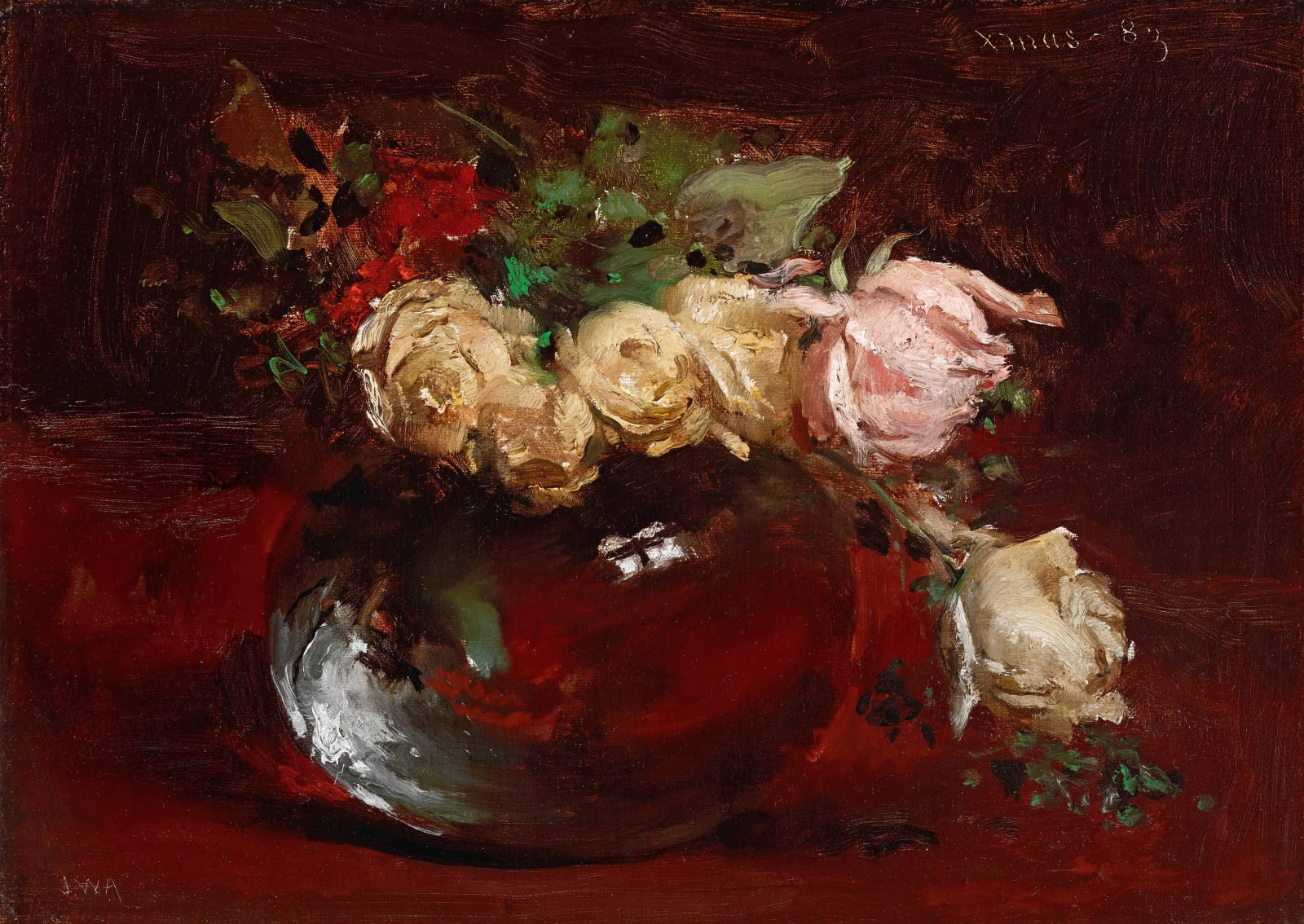John White Alexander 1856-1915
Still Life, 1883
Oil on canvas
10 1/8 x 14 1/4 inches (25.7 x 36.2 cm)
Framed dimensions: 19 5/8 x 23 5/8 inches
Framed dimensions: 19 5/8 x 23 5/8 inches
Signed lower left: JWA
Inscribed upper right: Xmas 1883
Inscribed upper right: Xmas 1883
John White Alexander's graceful depictions of beautiful women earned him critical acclaim both in Europe and America. However, his career did not get off to an easy start—Alexander became an...
John White Alexander's graceful depictions of beautiful women earned him critical acclaim both in Europe and America. However, his career did not get off to an easy start—Alexander became an orphan at the age of five and was raised instead by his grandfather in Allegheny City, Pittsburgh. Due to a combination of fortunate connections and prodigious talent, he traveled to New York City and landed a position as an office boy with Harper’s in May, 1875. Although relatively untrained, he progressed quickly and was soon working as an illustrator. However, Alexander was eager to travel, and in the fall of 1877, he set off for Europe with several companions. They stopped briefly in Paris before continuing on to Munich, where Alexander enrolled for a time at the Royal Academy.
By 1878, Alexander had grown disillusioned with the Academy and on a visit to nearby Polling, he discovered the thriving colony of painters all studying under the American artist, Frank Duveneck. Alexander stayed on and flourished in this stimulating environment, where he became close friends with Duveneck and “head of all the boys.” When Duveneck relocated his school to Florence, Italy, Alexander followed him there and continued to hone his skills in the company of such highly esteemed artists as James A. M. Whistler. Despite this remarkable milieu, Alexander was homesick for Pittsburgh, Pennsylvania, and he finally left for America in August, 1880.
This exquisite still life of roses demonstrates Alexander’s natural talent and his incredible facility with the medium of oil paint. Painted in 1883, not long after his return home, it also demonstrates how thoroughly he had adopted the signature Munich style, which he learned under the tutelage of Duveneck. The color palette is dark and rich, and the roses are deftly rendered with the broad bravura brushwork that is so typical of this style of painting. As the inscription “Xmas – 83” suggests, this still life was given as a Christmas gift to Agnes Clarke, who was the sister to Thomas Shields Clarke, a close friend of Alexander’s. The Clarke’s were a socially prominent family, also from Allegheny City, Pittsburgh, although Alexander’s friendship with Thomas Clarke developed in the early 1880s when Alexander became an instructor at the School of Science at Princeton and Clarke was enrolled as a pupil. According to family lore, Alexander was in love with Agnes Clarke at the time, however, if this was the case, the romance never progressed very far. By 1884, Alexander had begun to court Elizabeth Swan Williamson Alexander, whom he later married in 1887. Agnes married one year later, however, she kept the painting, which remained in the family until 2019.
By 1878, Alexander had grown disillusioned with the Academy and on a visit to nearby Polling, he discovered the thriving colony of painters all studying under the American artist, Frank Duveneck. Alexander stayed on and flourished in this stimulating environment, where he became close friends with Duveneck and “head of all the boys.” When Duveneck relocated his school to Florence, Italy, Alexander followed him there and continued to hone his skills in the company of such highly esteemed artists as James A. M. Whistler. Despite this remarkable milieu, Alexander was homesick for Pittsburgh, Pennsylvania, and he finally left for America in August, 1880.
This exquisite still life of roses demonstrates Alexander’s natural talent and his incredible facility with the medium of oil paint. Painted in 1883, not long after his return home, it also demonstrates how thoroughly he had adopted the signature Munich style, which he learned under the tutelage of Duveneck. The color palette is dark and rich, and the roses are deftly rendered with the broad bravura brushwork that is so typical of this style of painting. As the inscription “Xmas – 83” suggests, this still life was given as a Christmas gift to Agnes Clarke, who was the sister to Thomas Shields Clarke, a close friend of Alexander’s. The Clarke’s were a socially prominent family, also from Allegheny City, Pittsburgh, although Alexander’s friendship with Thomas Clarke developed in the early 1880s when Alexander became an instructor at the School of Science at Princeton and Clarke was enrolled as a pupil. According to family lore, Alexander was in love with Agnes Clarke at the time, however, if this was the case, the romance never progressed very far. By 1884, Alexander had begun to court Elizabeth Swan Williamson Alexander, whom he later married in 1887. Agnes married one year later, however, she kept the painting, which remained in the family until 2019.
Provenance
Gift from the artist to Agnes Clarke, Allegheny, Pennsylvania, 1883;By descent in the family to Clarke's grand-niece, New Hampshire, until 2019;
Private collection, Pennsylvania;
By descent in the family, until 2024
Please join our mailing list
* denotes required fields
We will process the personal data you have supplied in accordance with our privacy policy (available on request). You can unsubscribe or change your preferences at any time by clicking the link in our emails.



